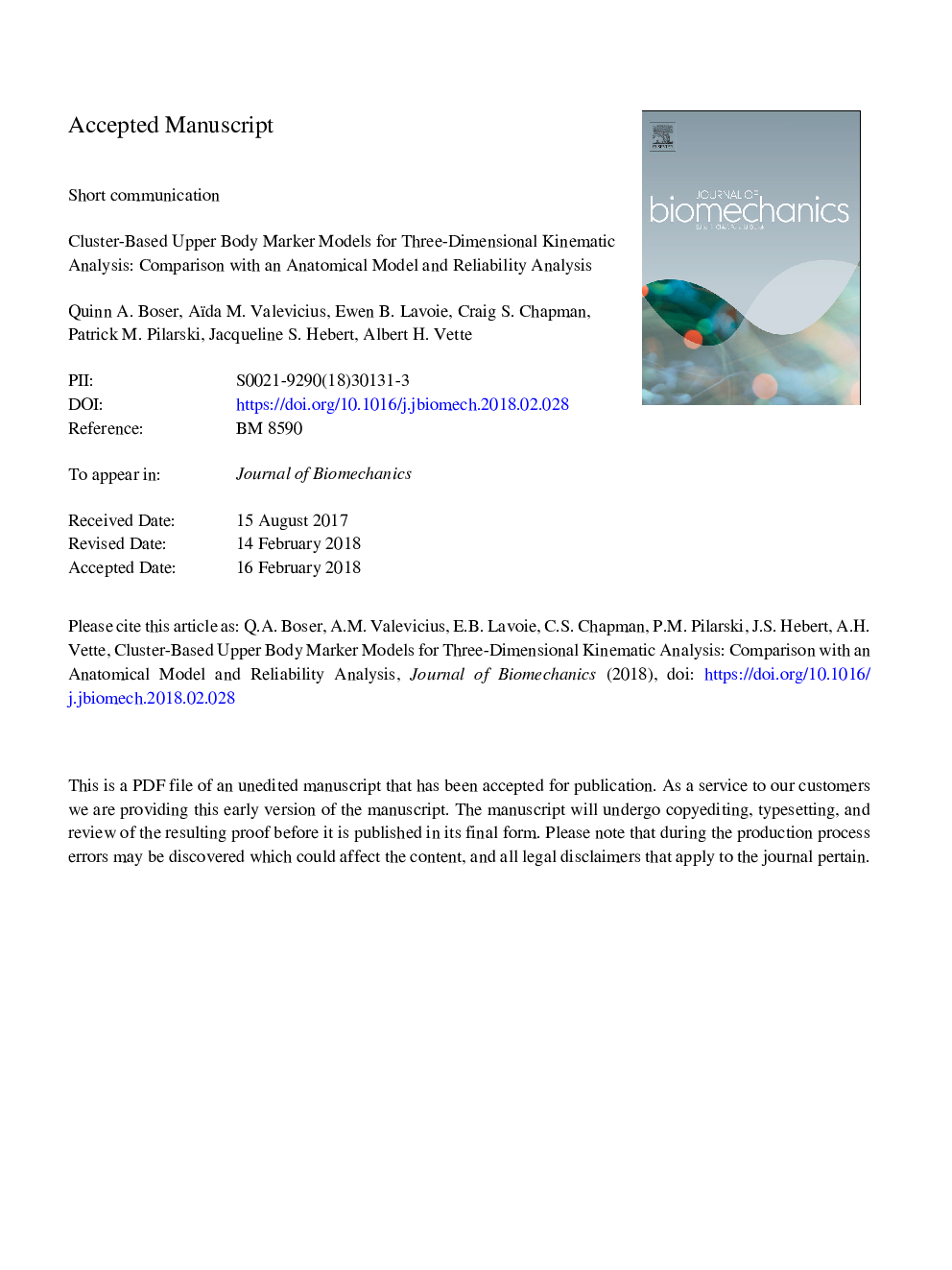| کد مقاله | کد نشریه | سال انتشار | مقاله انگلیسی | نسخه تمام متن |
|---|---|---|---|---|
| 7236359 | 1471092 | 2018 | 22 صفحه PDF | دانلود رایگان |
عنوان انگلیسی مقاله ISI
Cluster-based upper body marker models for three-dimensional kinematic analysis: Comparison with an anatomical model and reliability analysis
ترجمه فارسی عنوان
مدل های مارکر فوق العاده مبتنی بر خوشه ای برای تجزیه و تحلیل سینماتیک سه بعدی: مقایسه با یک مدل آناتومی و تحلیل قابلیت اطمینان
دانلود مقاله + سفارش ترجمه
دانلود مقاله ISI انگلیسی
رایگان برای ایرانیان
ترجمه چکیده
اندازه گیری کینماتیک مفصلی زاویه ای بدن فوقانی یک روش مفید برای ارزیابی عملکرد اندام فوقانی است. زوایای مشترک معمولا از طریق ضبط حرکت، نشانگرهای ردیابی روی نشانه های تشریحی قرار می گیرند. این روش با محدودیت هایی همچون بار اداری، مصنوعات بافت نرم و متغیر داخلی و بین تستر همراه است. یک روش جایگزین شامل ردیابی خوشه های مارکر سفت و سخت در قسمت های بدن است که در مقایسه با نشانه های تشریحی یا زوایای شناخته شده کالیبره شده است. با این وجود دقت و قابلیت اطمینان استفاده از این روش خوشه ای در بدن فوق العاده به طور جامع مورد بررسی قرار نگرفته است. هدف ما مقایسه سه مدل مختلف خوشه بالایی با یک مدل تشریحی با توجه به زوایای مشترک و قابلیت اطمینان بود. شرکت کنندگان غیر فعال غیرفعال دو وظیفه فوق العاده عملکردی استاندارد را با استفاده از نشانگرهای تشریحی و خوشه ای به طور همزمان اعمال کردند. منحنی های زاویه مشترک حاصل از خوشه های مارکر با سه روش مختلف کالیبراسیون با آناتومی مدل مقایسه شد و قابلیت اطمینان بین جلسه برای تمام مدل ها مورد ارزیابی قرار گرفت. مدل های خوشه ای، منحنی های زاویه مشترک ایجاد شد که با مدل های آناتومیک قابل مقایسه بود و بسیار همبسته بود، اما تفاوت های قابل توجه و تفاوت های حساسیتی را برای برخی از درجه آزادی نشان داد. قابلیت اطمینان بین ایستگاه بین تمام مدل ها قابل مقایسه است و برای اکثر آزادی ها مناسب است. به طور کلی، مدل های خوشه ای زاویه های قابل اعتماد مکانی را تولید می کنند که با استفاده از خروجی های آناتومیک نمی توان به طور معکوس برای محاسبه معیارهای سینماتیک استفاده کرد. مدل های خوشه ای به نظر می رسد که جایگزین کافی و احتمالا مطلوب برای مدل های تشریحی است که هدف آن ارزیابی روند تغییر رفتار است.
موضوعات مرتبط
مهندسی و علوم پایه
سایر رشته های مهندسی
مهندسی پزشکی
چکیده انگلیسی
Quantifying angular joint kinematics of the upper body is a useful method for assessing upper limb function. Joint angles are commonly obtained via motion capture, tracking markers placed on anatomical landmarks. This method is associated with limitations including administrative burden, soft tissue artifacts, and intra- and inter-tester variability. An alternative method involves the tracking of rigid marker clusters affixed to body segments, calibrated relative to anatomical landmarks or known joint angles. The accuracy and reliability of applying this cluster method to the upper body has, however, not been comprehensively explored. Our objective was to compare three different upper body cluster models with an anatomical model, with respect to joint angles and reliability. Non-disabled participants performed two standardized functional upper limb tasks with anatomical and cluster markers applied concurrently. Joint angle curves obtained via the marker clusters with three different calibration methods were compared to those from an anatomical model, and between-session reliability was assessed for all models. The cluster models produced joint angle curves which were comparable to and highly correlated with those from the anatomical model, but exhibited notable offsets and differences in sensitivity for some degrees of freedom. Between-session reliability was comparable between all models, and good for most degrees of freedom. Overall, the cluster models produced reliable joint angles that, however, cannot be used interchangeably with anatomical model outputs to calculate kinematic metrics. Cluster models appear to be an adequate, and possibly advantageous alternative to anatomical models when the objective is to assess trends in movement behavior.
ناشر
Database: Elsevier - ScienceDirect (ساینس دایرکت)
Journal: Journal of Biomechanics - Volume 72, 27 April 2018, Pages 228-234
Journal: Journal of Biomechanics - Volume 72, 27 April 2018, Pages 228-234
نویسندگان
Quinn A. Boser, Aïda M. Valevicius, Ewen B. Lavoie, Craig S. Chapman, Patrick M. Pilarski, Jacqueline S. Hebert, Albert H. Vette,
